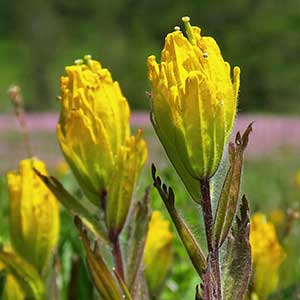Castilleja viscidula
Castilleja levisecta
sticky Indian paintbrush, sticky paintbrush
golden Indian paintbrush, golden paintbrush
several, ascending to erect, decumbent at base, unbranched, sometimes branched, hairs spreading, long, soft, mixed with shorter stipitate-glandular ones.
few to many, erect, ± decumbent or creeping at base, unbranched, sometimes branched, hairs spreading, medium length and long, soft, mixed with short stipitate-glandular ones.
green to brown, linear, linear-lanceolate, lanceolate, or oblong (narrowly ovate nearing inflorescence), 1–4(–5) cm, not fleshy, margins wavy, flat or involute, (0–)2(–5)-lobed, apex acute;
lobes ascending-spreading, oblong to narrowly lanceolate, apex acute or obtuse.
green to purple or brown-tinged, linear-lanceolate proximally, oblong-ovate or -obovate distally, 0.8–5.2 cm, not fleshy, margins plane, distalmost sometimes ± wavy, involute, 3–7(–11)-lobed, apex obtuse;
lobes erect to ascending, linear to linear-spatulate, very short, toothlike, usually arising from distal 1/3 of blade, apex rounded.
2–14 × 1–3.5 cm;
bracts proximally greenish to greenish brown, distally pale yellow, cream, or yellow-green, sometimes yellow-orange or red (sometimes gradually differentiated from proximal coloration), lanceolate, broadly lanceolate, or oblong, 3(–5)-lobed, proximal wavy-margined;
lobes ascending, linear to narrowly lanceolate, long, arising near or above mid length, sometimes wavy-margined, apex acute to rounded.
2.5–25 × 1–4 cm;
bracts bright yellow throughout, or proximally greenish, distally bright yellow, sometimes deep yellow-orange, especially with age, oblong, elliptic, or obtuse to ovate, (0–)5–9(–13)-lobed, sometimes wavy-margined;
lobes erect to ascending, oblong, short to medium length, arising above mid length, central lobe apex rounded, lateral ones rounded to acute.
straight, 16–22(–25) mm;
tube 10–15 mm;
beak exserted, straight to sometimes curved, adaxially green to yellow, 5–8(–9) mm;
abaxial lip green or yellow, sometimes deep purple, reduced, inconspicuous, often visible in abaxial cleft, 1–2 mm, 20% as long as beak;
teeth erect, green to white, sometimes yellow or pink, 0.5–1 mm.
straight or slightly curved, 17–28 mm;
tube 12–15 mm;
beak exserted, adaxially green or greenish yellow, 6–8 mm;
abaxial lip yellow or greenish, reduced, not inflated, 2–3 mm, 25–33(–50)% as long as beak;
teeth ascending to erect, yellow, 0.5–1.5 mm.
colored as bracts or proximally paler, (10–)14–18 mm;
abaxial and adaxial clefts (4–)5–9 mm, 30–40% of calyx length, deeper than laterals, lateral (1–)2–6 mm, ca. 25% of calyx length;
lobes narrowly ovate to lanceolate, linear, or narrowly lanceolate, apex acute to obtuse.
distally yellow, 13–22 mm;
abaxial and adaxial clefts 4–9.5 mm, 30–40% of calyx length, deeper than laterals, lateral 2.5–4.5 mm, ca. 25% of calyx length;
lobes linear to narrowly oblong or narrowly lanceolate, apex obtuse, sometimes rounded to acute.
= 24, 72.
= 24.
Castilleja viscidula
Castilleja levisecta
Castilleja viscidula is a member of the complex including C. applegatei and C. martini, centered in California. Castilleja viscidula favors isolated mountain ranges, from the Wallowa and, possibly, the Blue mountains of northeastern Oregon, eastward into southwestern Idaho, and southward into central Nevada. Most populations are greenish yellow, but in one portion of the Wallowa Mountains, reddish bracted plants are common. Many yellowish bracted populations in the same mountain range surround this reddish population. Intermediate color forms are rarely encountered. Most ranges where C. viscidula occurs have generated slightly differing local races, demonstrating some reproductive isolation and divergence. In addition, hybrid swarms between this species and C. nana are known from several mountain ranges in central and northern Nevada, and an apparent hybrid with C. flava var. flava is known from the Independence Mountains of northern Nevada.
(Discussion copyrighted by Flora of North America; reprinted with permission.)
Castilleja levisecta is listed as threatened in the United States and endangered in Canada, where it is extremely rare. Most of its grassland habitat has been altered by development in the Puget Trough, and there are historical stations in the metro areas of what are now Victoria, Portland, and Seattle. For several decades, C. levisecta was considered extirpated from Oregon. However, recent reintroduction programs in Oregon and Washington have been very successful at reestablishing this species at several sites in the Willamette Valley. The bright yellow inflorescences often gradually age to a golden yellow color, unique in the genus.
Castilleja levisecta is in the Center for Plant Conservation’s National Collection of Endangered Plants.
(Discussion copyrighted by Flora of North America; reprinted with permission.)


